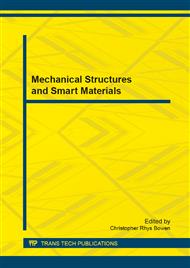[1]
J.A. Sauer, D.C. Lemmon, E.K. Lynn. Bolts: How to Prevent Their Loosening. Machine Design, Vol. 22 (1950), p.133.
Google Scholar
[2]
S.C. Gambrell. Why Bolts Loosen. Machine Design, Vol. 40 (1968), p.163.
Google Scholar
[3]
G.H. Junker. New Criteria for Self-Loosening of Fasteners under Vibration. SAE, Transactions, Vol. 78 (1969), p.314.
DOI: 10.4271/690055
Google Scholar
[4]
X. Yang, S.A. Nassar, and Z Wu. Criterion for Preventing Self-Loosening of Preloaded Cap Screws under Transverse Cyclic Excitation. ASME, Journal of Vibration and Acoustic, Vol. 133 (2011), Paper Number 041013.
DOI: 10.1115/1.4003596
Google Scholar
[5]
S.A. Nassar and B.A. Housari. Self-Loosening of Threaded Fasteners due to Cyclic Transverse Loads. ASME, Proceedings of PVP2005, Paper Number PVP2005-71577.
DOI: 10.1115/pvp2005-71577
Google Scholar
[6]
Y. Jiang and M. Zhang. An Experimental Study of Self-Loosening of Bolted Joints. ASME, Journal of Mechanical Design. Vol. 126(2004), p.925.
Google Scholar
[7]
N.G. Pai and D.P. Hess. Three-Dimensional Finite Element Analysis of Threaded Fastener Loosening due to Dynamic Shear Load. Engineering failure analysis, Vol. 9 (2002), pp.383-402.
DOI: 10.1016/s1350-6307(01)00024-3
Google Scholar
[8]
S. Izumi, M. Kimura, and S. Sakai. Small Loosening of Bolt-Nut Fastener due to Micro Bearing-Surface Slip: Finite Element Method Study. Journal of solid mechanics and materials engineering, Vol. 72(2006), p.780.
DOI: 10.1299/jmmp.1.1374
Google Scholar
[9]
S. Izumi, T. Yokoyama, M. Kimura and S. Sakai. Loosening-Resistance Evaluation of Double-Nut Tightening Method and Spring Washer by Three-Dimensional Finite Element Analysis. Engineering Failure Analysis, Vol. 16(2009), p.1510.
DOI: 10.1016/j.engfailanal.2008.09.027
Google Scholar
[10]
Y. Shoji and T. Sawa. Self-Loosening Mechanism of Nuts due to Cyclic Thermal Load. ASME, Proceedings of PVP2009, Paper Number. PVP 2009-77447.
DOI: 10.1115/pvp2009-77447
Google Scholar
[11]
Z. Ming, Y. Jiang. Finite Element Modeling of Self-Loosening of Bolted Joints. ASME, Journal of Mechanical Design, Vol. 129(2007), p.128.
Google Scholar
[12]
G. Dinger and C. Friedrich. Avoiding Self-Loosening Failure of Bolted Joints with Numerical Assessment of Local Contact State. Engineering Failure Analysis, Vol. 18(2011), p.2188.
DOI: 10.1016/j.engfailanal.2011.07.012
Google Scholar


